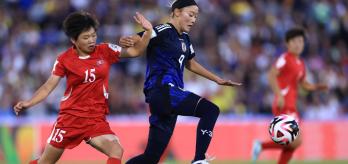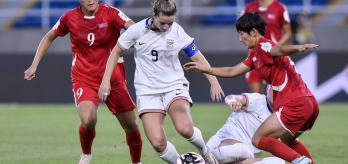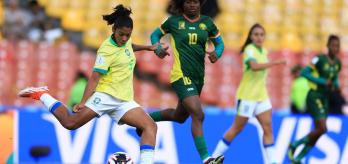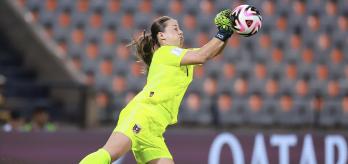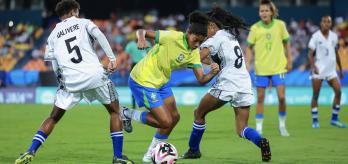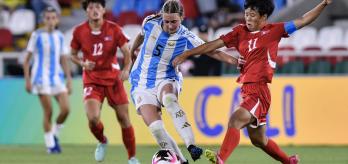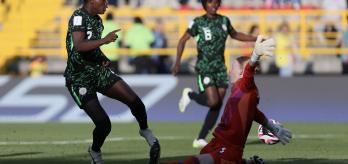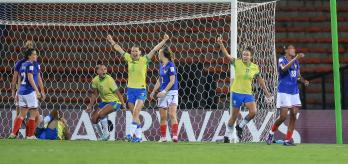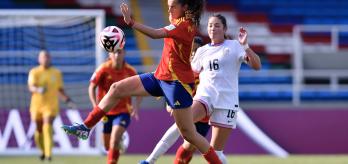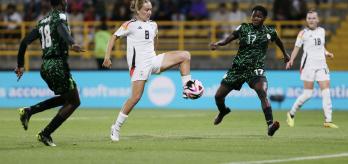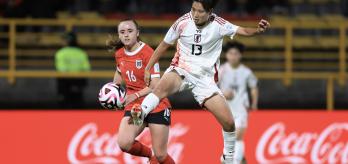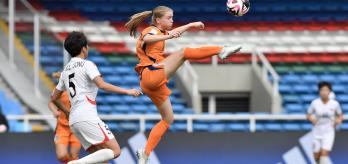In their opening Group D match against Venezuela, Germany’s three central midfielders were extremely influential in how they progressed their play, displaying a catalogue of high-quality technical mastery and understanding when interacting with the ball, and each other.
Former USA national team player, Heather O’Reilly, explains how this technical prowess was the platform for how they dictated the speed and rhythm of the game, and advanced their team’s play.
“The three Germany midfielders, Alara Şehitler (17), Sofie Zdebel (8) and Sophie Nachtigall (10), had lots of good habits and played with attention to detail. From scanning the pitch before receiving the ball, to using their body shape to both protect the ball and open up the pitch, they were able to generate real forward momentum. They had real understanding of the three central midfield roles and rotated the responsibilities between them depending on who was best placed to drive forward, who could make attacking runs into the penalty area and who should be the one to cover the defensive midfield position.
“For such young players, they demonstrated a real understanding of the game and their roles within it. I also really liked their awareness of how to pass the ball in certain situations so that the player receiving could generate forward momentum,” O’Reilly added.
Receiving between the opposition shape & good use of scanning
Germany’s midfielders were constantly moving to make offers to receive and were competent at receiving the ball under pressure. In addition, their centre-backs were confident in playing into them, even when they were in tight spaces. A key reason for this was in how Şehitler, Zdebel and Nachtigall scanned the pitch before receiving, and subsequently how they adapted their body shape accordingly to receive on the half-turn when possible and play forward or wide.
As O’Reilly explains, “The three players were able to receive between Venezuela’s lines, even when their opponents were compact with limited space available, but what was really impressive was how closely they worked together and the understanding between them. As we can see in clip 1 below, they remain connected and involved as their centre-backs attempt to build the play. Just before the left centre-back, Veit (4), plays the line-breaking pass into Şehitler, the deep midfielder scans the pitch to see where the opposition players are and where the space in between the lines is available.
“Once she sees this, she advances into the space between and behind the first line of Venezuela’s defence and opens her body shape to receive on her back foot, allowing her to play forward. This technical detail of scanning before receiving, deciding on body position to receive and receiving on the back foot are key in her ability to advance the play. The type of pass here is also important because the player passing the ball also recognises where to play the ball in order to advance the play,” O’Reilly added.
“At all times in this clip, one of the three midfielders is in the deeper holding role, and as the play advances into the final third, we see the run from Zdebel into the penalty area, where Germany have a total of four players looking to attack the ball.”
Creating overloads through midfield fluidity
In this match, Germany played a 1-4-3-3 against Venezuela’s 1-4-4-2, with a centre-midfield trio comprising of one defensive midfielder and two advanced team-mates: one of whom played box-to box while the other added to the attacking line when they were building their attacks. While Şehitler was the player that occupied the defensive midfield role most, both Zdebel and Nachtigall also fulfilled this role when required, on occasions where Şehitler was involved in the progressions higher up the pitch.
This game intelligence and trust in each other really helped them play at a high tempo because a player could drive forward if they were best placed to do so, knowing that one of their other midfielders would cover for them.
According to O’Reilly, this synergy and understanding of their roles and responsibilities was a key component in the effective functioning of Germany’s midfield and their influence on progressing play.
“Their awareness and the speed at which they recognised the roles that needed to be covered was impressive. Because of Venezuela’s 1-4-4-2 formation, Germany naturally had a numerical overload in the middle of the pitch, and this put pressure on the opposition defenders to come out from the defensive line and get pressure on the spare midfielder. When this happened, Germany were very good at recognising this and exploiting the space vacated. What I liked most, was that all three midfielders could play the attacking and supporting roles and in every attacking situation, at least one midfielder advanced to join the attack and one held the deeper supporting position,” she explained.
A great example of this can be seen in clip 2 below. As Şehitler gets involved in the build-up with her centre-backs, she pulls wide, opening space centrally. Zdebel immediately recognises this and drops down to make an offer to receive, dragging Venezuela’s right centre-back with her. As the left centre-back tries to cover the space centrally, she leaves a gap with her left-back, and as the play progresses, Nachtigall attacks this space making a run in behind.
Midfield supporting the attack
Once Germany progressed their play into the final third, at least one of their central midfielders joined that attack. Once they could break lines centrally, Germany liked to advance the play into the final third by going into their wide areas with runs from forward players and midfielders into the penalty area. This meant the player in possession always had several options when considering their delivery to the penalty area. In addition, if Germany lost the ball, they had numbers high to initiate a counter-press.
O’Reilly explains the key qualities of the midfielders that added to their dynamic synergy in progressing their teams’ attacks.
“Şehitler is a clever player, and I liked her willingness to go forward by turning or penetrating. She didn’t only look to play bounce passes with her team-mates, she knew when to use them to create space and move opposition players but also had the confidence, technique and willingness to play forward. Zdebel has a great ability to pass and run at speed. She spots gaps and uses the trigger of the ball going wide to make those attacking runs from midfield to add to the attack. She also had the awareness to hold the deeper position to cover for Şehitler when she advanced. Nachtigall could also rotate but she was predominantly the highest of the midfielders, always looking to drag defenders out position and penetrate the spaces left vacant by them.
“Other players knew their roles too, wide players stayed wide and let the midfield trio work their magic inside. They were very proactive at working the wide channels, creating angles to receive from their midfielders so they progress the attacks into the final third while their centre-forward kept the centre-backs occupied,” she added.
In clips 3 and 4 below we see two great examples of all the components detailed above. In addition, the choice of passes (weight, distance, angle) and the execution of those passes is worth noting as players demonstrated an understanding of how best to play to the receiving player to facilitate a first touch that would generate and maintain attacking momentum.
Summary
The relationship between Germany’s three central midfielders, and their understanding of each other's roles and responsibilities was key to their ability to progress their team’s play. The fluidity of their movement and the trust that existed between them to cover for each other allowed them to play with speed when disrupting and breaking their opponent’s defensive lines.
Individually, the attention to detail demonstrated in their different techniques was critical. Their importance of their passing intelligence, scanning before receiving, body positions when receiving cannot be underestimated in their success at progressing the ball.






